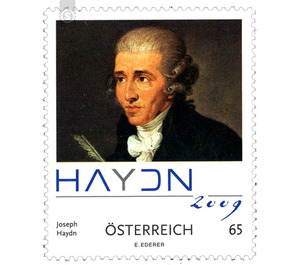200th anniversary of death - Austria / II. Republic of Austria 2009 - 65 Euro Cent
Theme: Art & Culture
| Country | Austria / II. Republic of Austria |
| Issue Date | 2009 |
| Face Value | 65.00 |
| Edition Issued | 1,200,000 |
| Printing Type | offset |
| Stamp Type | Commemorative |
| Item Type | Stamp |
| Chronological Issue Number | 2135 |
| Chronological Chapter | OOS-OE2 |
| SID | 245954 |
| In 52 Wishlists | |
Joseph Haydn (March 31, 1732 to May 31, 1809) was a leading Austrian composer of the so-called "Viennese Classic". Born in Rohrau in Lower Austria, he grew up in simple circumstances. In 1740, the musical director of St. Stephen's Cathedral discovered him in his search for young talents; He brought him to Vienna, where he then sang for nine years with the Boys Choir of St. Stephan and received singing, piano and violin lessons. After a difficult time as a freelance musician Haydn received in 1761 a position as vice-Kapellmeister in the princely house Esterházy, where he worked in the episode almost three decades. In 1766 he was promoted to first Kapellmeister - in this position he was responsible for composition, direction of the orchestra, playing chamber music and arranging opera productions. The daily access to his own small orchestra helped his artistic development - and even outside the Esterházy house Haydn's reputation grew rapidly: from 1785 to 1786 he composed, for example, the Parisian symphonies, which were commissioned from abroad. From a highly artistic fertilizing friendship with Wolfgang Amadeus Mozart emerged several important works; Three of the so-called "Haydn Quartets" were premiered with the two masters personally on the instruments. 1790 Haydn was dismissed by the Esterházy house in the pension. The subsequent trips to England were a great success; Here he composed some of his most famous works: the "Symphony with a bang", the "London Symphony" and the "Equestrian Quartet". Despite the great fame in England, Haydn remained true to Vienna. In 1793 he bought a house with a garden in the suburb of Gumpendorf (today's "Haydn House" with its own museum). This is where most of his works of old age were created, including the two world-famous oratorios "The Creation" and "The Seasons". Only in old age did the genius literally outstrip itself, while at the same time his physical condition deteriorated. On May 31, 1809 Joseph Haydn died in his house in Gumpendorf. The extensive work left by the great composer is still played worldwide today and is appreciated by millions of music lovers. Joseph Haydn has written 108 symphonies, 24 operas, 14 masses, six oratorios, 35 concertos for various solo instruments, 83 string quartets, 46 piano trios, 21 string trios, 52 piano sonatas and a great wealth of songs, motets and cantatas.


